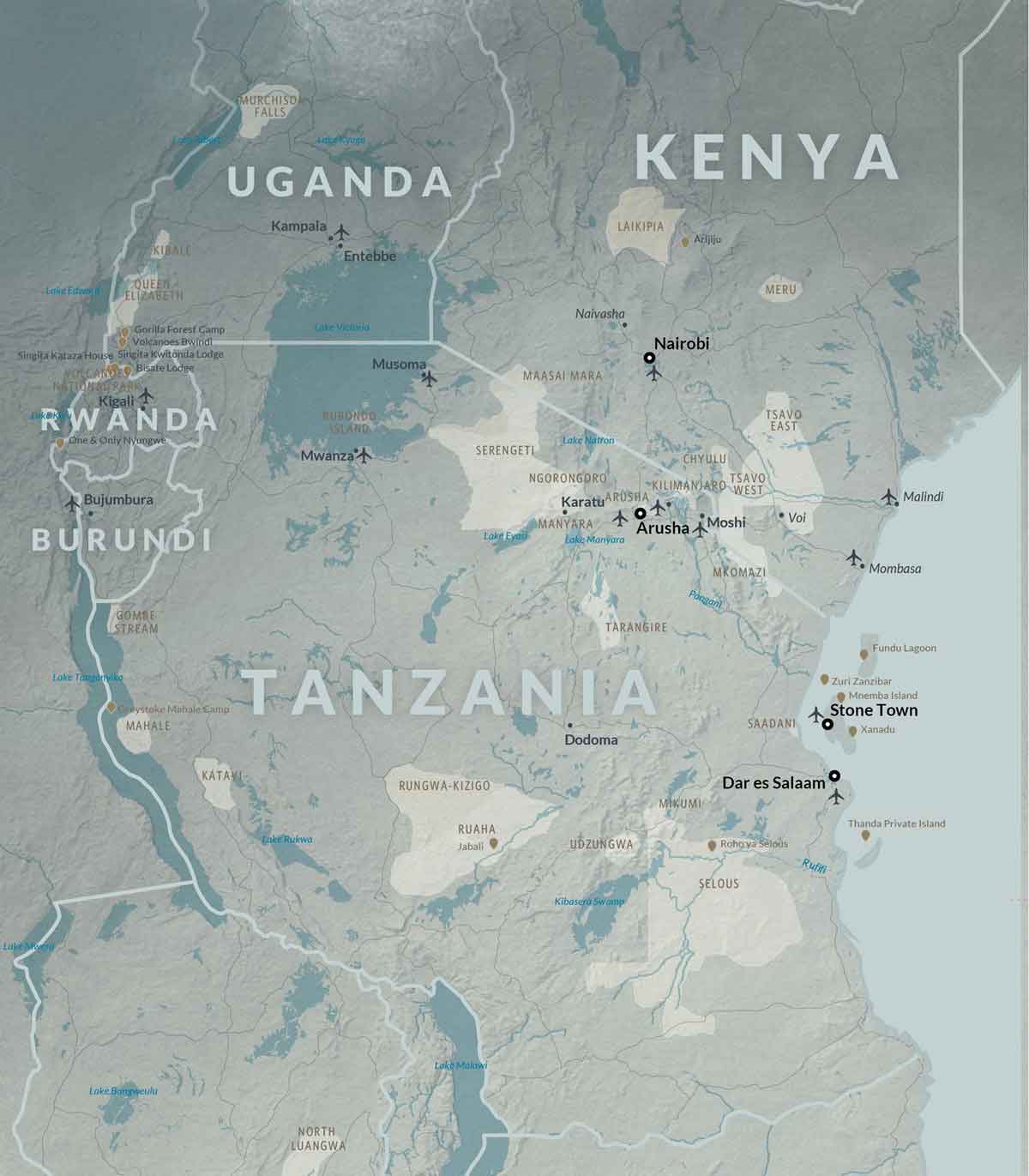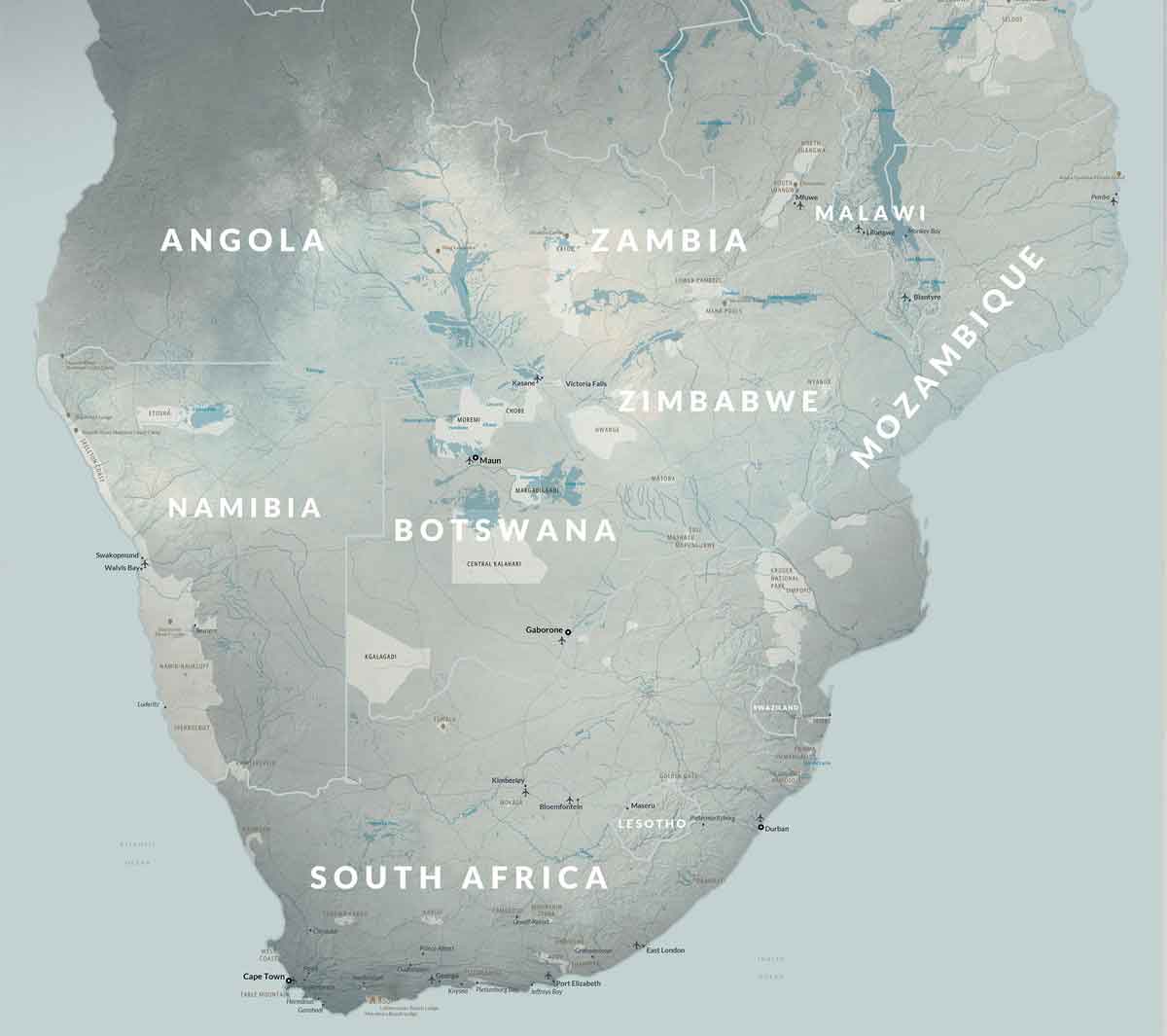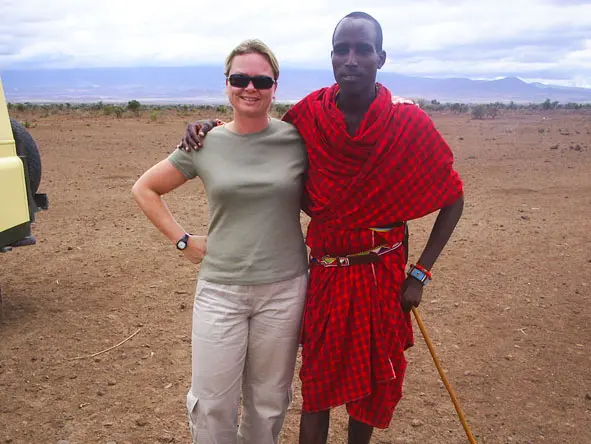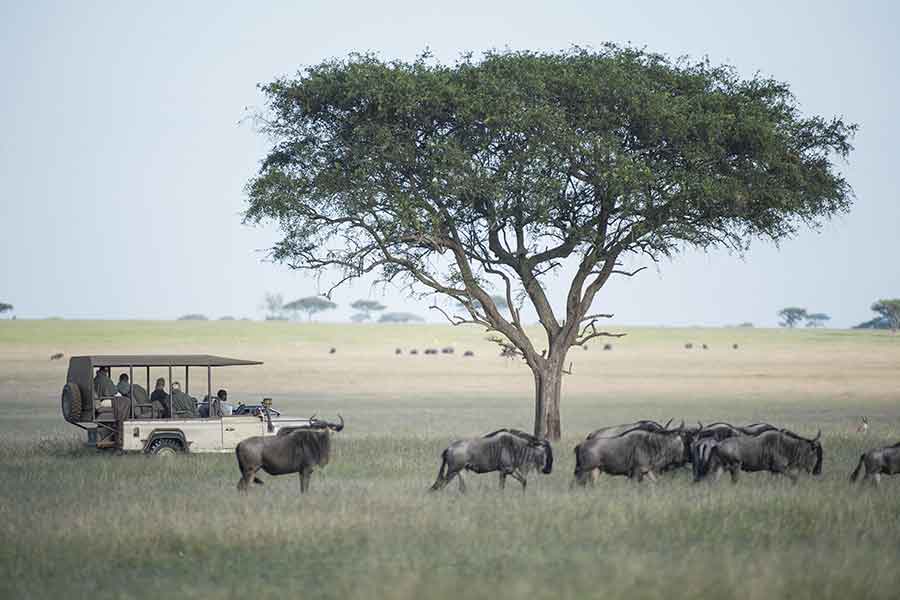Language
- Deutsch
- English
- Español
- Français
- Italiano
- Nederlands
- Português
Currency
- AUD Australian Dollar
- CAD Canadian Dollar
- EUR Euro
- GBP Pound Sterling
- SGD Singapore Dollar
- USD US Dollar
- ZAR Rand

Should I go on safari in Tanzania or South Africa? Or how about a Kenya vs South Africa safari, or even an Uganda vs Kenya safari? These are among the most frequently asked questions we receive when travellers are considering an East African vs Southern African safari. Both regions boast a variety of unique safari destinations, many of which are celebrated as some of the best places to go on safari.
Since 1998, we've tailor-made exceptional African safari experiences for thousands of travellers from across the globe. Our expertise is based on first-hand experience – we travel the length and breadth of every destination we recommend – to make sure that every part of our travellers’ itineraries is tried-and-tested.
So which is better, an East or Southern Africa safari? Well, that depends entirely on what you want to see and experience. We've broken down the key differences between the two regions to help you decide which is best for your travel wishes…
| East Africa | Southern Africa | ||||
|---|---|---|---|---|---|
| Safari Countries | Kenya Tanzania Rwanda Uganda |
Botswana South Africa Namibia Zimbabwe Zambia |
|||
| Top National Parks & Game Reserves | Masai Mara Samburu Serengeti Ngorongoro Crater Volcanoes National Park Bwindi Impenetrable Forest |
Okavango Delta Chobe National Park Kruger National Park Etosha National Park Victoria Falls Hwange National Park Mana Pools South Luangwa Lower Zambezi |
|||
| Dry Seasons | Jan–Mar Jun–Oct |
May–Oct Oct–Apr (Cape Town) |
|||
| Wet / Green Seasons | Nov–Dec Apr–May |
Nov–Apr May–Aug (Cape Town) |
|||
| Highlights | Wildebeest Migration Cultural interactions. Mount Kilimanjaro Gorilla trekking. Year-round game viewing. Natural beauty and wide-open spaces. Easily add a tropical island to a safari itinerary. |
Big 5 game viewing. Cape Town Whale watching. Victoria Falls Aquatic safaris in Botswana. Walking safaris in Zambia. Stargazing and desert safaris in Namibia. World-class service and amenities in South Africa. |

East Africa is the eastern region of the African continent and includes safari heavyweights like Kenya, Tanzania, Uganda and Rwanda, as well as the Indian Ocean islands of Zanzibar and the Seychelles.
The region is renowned for its massive concentrations of wild animals and stunning scenery. Shaped by the tectonic forces that created the Great East African Rift, some of East Africa's biggest geographic landmarks include Mount Kilimanjaro and Mount Kenya – the two tallest peaks on the continent. East Africa is also home to the world's second-largest freshwater lake, Lake Victoria and Lake Tanganyika, the world's second-deepest lake.
East Africa's climate is atypical of equatorial regions, surprisingly cool and dry for its latitude. Thanks to this temperate climate and East Africa's abundant resident wildlife, the region is widely regarded as a fantastic year-round safari destination. Its wide and open plains mean there is virtually always game to see, no matter what time of year you visit.

Southern Africa is the southernmost region of the African continent and includes countries like Botswana, Malawi, Mozambique, Namibia, South Africa, Zambia and Zimbabwe.
Southern Africa's terrain is incredibly diverse, ranging from forests and grasslands to deserts. The region is also home to both mountains and low-lying coastal areas, as well as a wide variety of ecoregions including grassland, bushveld, semi-desert, savannah, and riparian areas.
These diverse landscapes and terrain, are a result of the distinct climactic conditions throughout the region. It ranges from Mediterranean in the southwestern corner of the continent to temperate, subtropical and even desert-like further north. Most of the region enjoys warm, sunny days and cool nights.
The Masai Mara National Reserve‘s wide-open plains provide a sanctuary for an abundance of animals like elephant, buffalo, zebra, giraffe, hyena and the Mara's famous big cats: lion, leopard and cheetah. The Wildebeest Migration's mega-herds roll in from about July to November, before crossing back to the Serengeti. We recommend staying in one of the private conservancies bordering the Masai Mara – especially during Migration season – as the national reserve can get rather busy. You'll have the benefit of being close to all the Migration hot spots, but still be able to retreat to peace and tranquillity. Plus, you're able to enjoy special activities like off-road game viewing, bush walks and night game drives – which are not permitted in the national reserve.
Amboseli National Park‘s perennial wetlands flourish beneath towering Mount Kilimanjaro and is the best place in East Africa to see massive herds of elephant. If you're looking for that iconic postcard image of wildlife against a Kili backdrop, this is the place to get the shot. Amboseli is also renowned for great sightings of lion, buffalo, leopard, hyena, giraffe and cheetah, and special activities like horseback safaris.
Samburu National Reserve is an arrestingly beautiful, rocky landscape that heralds Kenya's vast northern deserts. It's the traditional homeland of the Samburu people and a haven for the unique Special 5: Beisa oryx, reticulated giraffe, Grevy's zebra, long-neck gerenuk, and Somali ostrich. A Samburu safari offers luxurious tented camps and lodges, as well as unique activities like game viewing by camelback.
Laikipia‘s high plains are increasingly recognised as one of Kenya's best safari regions. It's home to some of the country's most encouraging conservation success stories like Lewa Wildlife Conservancy, a sanctuary for black and white rhinos as well as Grevy's zebra. This hidden gem destination has low visitor numbers and fantastic family-friendly safari lodges and camps.
The Serengeti National Park is home to one of the world's greatest concentrations of wildlife and the majority of the Wildebeest Migration (about December to October). It's Tanzania's flagship conservation area and a must-do for first-time and returning safari goers alike. The Serengeti is a sanctuary for an astonishing density of wildlife and offers a spectacular safari experience year-round.
The Ngorongoro Crater was created about 3 million years ago when a volcano exploded and collapsed on itself. It's the largest intact volcanic caldera on Earth and one of Africa's most spectacular natural wonders, supporting over 25,000 animals. A diverse ecosystem of savannah, lakes and forest, the crater is renowned for its geological splendour, out-of-this-world cliff-top accommodation, and for delivering East Africa's most reliable Big 5 game viewing.
Lake Manyara National Park is small by African standards yet boasts a tremendous diversity of habitats and animals – especially birds. Its namesake attracts a great array of aquatic birds while the evergreen forests are equally productive. It's also one of the best places to spot scarce tree-climbing lions. Lake Manyara is a beautiful park and conveniently located along Tanzania's famous northern safari route.
Tarangire National Park is famous for its striking baobab trees and massive elephant herds and is the fourth and final park on Tanzania's renowned northern safari circuit. The northern part of Tarangire is dominated by the perennial Tarangire River, which attracts colossal herds of elephants during Tanzania's dry season (June to October). The lesser-visited south is home to a series of vast swamps and wetlands that support a wide variety of wild animals.
Ruaha National Park and the Nyerere National Park (previously Selous Game Reserve) are part of the lesser-known Southern Tanzania safari region. Beautifully wild, enormous in size and filled to the brim with wildlife, these areas offer sensational safari experiences far away from the crowds.
No other wildlife encounter can rival sitting with endangered gorillas in their natural habitat and observing the fascinating family dynamics of our ancient relatives. The emerald rainforests of Rwanda's Volcanoes National Park and Uganda's Bwindi Impenetrable Forest National Park are incredible destinations for gorilla trekking, Africa's most powerful wildlife experience.
The Okavango Delta is the country's evergreen jewel and at the heart of Botswana's safari attractions. This vast inland river delta's meandering waterways are best explored on a mokoro, a traditional dug-out canoe, and the quintessential game drive ‘vehicle' of the Delta. Considered Africa's Garden of Eden, the Okavango Delta is home to an astonishing array of birds and big game – especially predators.
Chobe National Park is Africa's elephant kingdom. Home to around 120,000 individuals grouped in the largest herds on Earth, Chobe delivers some of the best and most close-up sightings of these gentle giants; especially around the Chobe River during Botswana's dry season (May to October). The park's remote Savuti region, a.k.a. ‘Predator City', is famous for its well-documented rivalries between powerful lion prides and hyena clans.
The Kalahari scrubland is home to unique experiences like quad biking (ATV) safaris and authentic cultural encounters with Africa's first people, the San. It's also the setting for Botswana's dazzling zebra migration, which happens between January and March (depending on seasonal rainfall).
The Kruger National Park is home to South Africa's greatest diversity of animals and exquisite safari lodges on private game reserves. As one of the oldest conservation areas in Africa, it boasts healthy populations of wildlife and highly sought-after sightings of cheetah and wild dog. But the Kruger's pièce de résistance is the almost guaranteed encounter with the super-celebrities of the safari circuit: Africa's iconic Big 5 (elephant, buffalo, rhino, lion and leopard).
Cape Town is technically not a safari destination per se, but it's a must-add to any South Africa itinerary. Continuously voted as one of the world's best cities to visit, Cape Town boasts beautiful mountains and beaches, historical landmarks and the bottle-green valleys of the renowned Cape Winelands.
Sossusvlei‘s mesmerising sand dunes are often referred to as the highest dunes on the planet. Situated in the Namib-Naukluft National Park, the biggest conservation area in Africa, Sossusvlei is one of the most spectacular sights in Namibia and delivers incredible photographic opportunities. Don't miss a visit to the eerily beautiful Deadvlei (‘dead marsh') and a climb up Dune 45 or Big Daddy (about 350m / 1,150ft) for a sunset you'll never forget.
Etosha National Park is considered by many safari aficionados as one of Africa's greatest wildlife reserves. It's a self-driver's paradise – thanks to its great roads – and home to four of the Big 5 (elephant, rhino, lion and leopard), as well as giraffe, cheetah and an abundance of plains game. During Namibia's dry season (May to October), the temporary water holes around Etosha Pan (a mineral pan four times the size of Los Angeles) host animal numbers of biblical proportions.
Hwange National Park is almost ten times the size of London and home to between 45,000 and 60,000 elephants. Aptly known as ‘the land of giants', Hwange delivers some of the best big game safari experiences in Africa, especially during the dry winter months (May to October) when animals congregate around the park's shallow pans and man-made waterholes.
Mana Pools is rugged and beautiful, boasting an alluring mix of grassy floodplains, woodlands and riverine forest. The park provided the backdrop to ‘Painted Wolves', one of the stories in BBC Earth's acclaimed Dynasties series. Visitors can enjoy traditional safari activities like game drives and nature walks, as well as river-based activities like kayaking, boating and fishing.
Victoria Falls needs no introduction. A visit to our planet's biggest waterfall is a must-do experience for anyone travelling to Southern Africa for a safari. High-water season runs from about March to July when the Zambezi River is in full flood and the waterfall is at its most thunderous. Low-water season is from about September to December and a good time for white-water rafting and swimming in Devil's Pool – an eddy at the edge of the waterfall.
South Luangwa National Park is a fantastic choice for big game viewing in Zambia. Few parks in Africa can match the phenomenal density of game that gathers around South Luangwa's lakes and rivers – from elephant, hippo and buffalo to well-fed lions. Africa takes on a whole new meaning when you experience it on foot, as the first explorers did, and nowhere does it better than South Luangwa: birthplace of the walking safari.
Lower Zambezi National Park is a peaceful reserve with wide floodplains and a wild mountain backdrop. It delivers superb game viewing, as well as some of the best water-based safari activities in Africa. A canoe safari is a fantastic way to get close to animals like elephant, buffalo and hippo – it's from the vantage point of a canoe that you truly understand the meaning of big game!
| East Africa | Southern Africa | ||||
|---|---|---|---|---|---|
| General Game Viewing | Excellent year-round thanks to massive concentrations of wildlife, temperate climate and wide-open landscapes. | Excellent during the dry season (May to October) when vegetation is less dense and animals stay close to water sources. | |||
| Big 5 Game Viewing | Reliable in Ngorongoro Crater and some private reserves in Kenya. | Almost guaranteed daily sightings in Kruger's private reserves. | |||
| The Wildebeest Migration | Witness it year-round in the Serengeti and Masai Mara. | N/A | |||
| Safari Vehicles | Generally closed 4x4s with three rows of seating and a pop-top roof hatch. | Generally open-sided 4x4s with tiered seating. | |||
| Popular Safari Activities | Game drives. Guided bush walks. Hot-air ballooning. Cultural tours. |
Game drives. Guided bush walks. Water-based activities like boat and canoe safaris. |
|||
| Transfers | Mostly by road and air. | Mostly by air. | |||
| Accommodation | Mainly authentic and traditional lodges and tented camps. | Mainly contemporary, luxury lodges. | |||
| Easy Add-ons | Gorilla trekking in Rwanda or Uganda. Tropical island holiday in Zanzibar or the Seychelles. |
Victoria Falls Cape Town Tropical island holiday in Mauritius. |

One big difference between a safari in East and Southern Africa is how close you can get to animals. In places like Kruger, Botswana and Zimbabwe, off-road game viewing is allowed but not in most of East Africa's parks – although it is allowed in the private conservancies and reserves. It's also much easier to do road safaris in East Africa, which allows you to combine several parks in one itinerary.
– Maureen Stover, Africa Safari Expert
| East Africa | Southern Africa | ||||
|---|---|---|---|---|---|
| Dry Season Game Viewing | Jan–Mar Jun–Oct |
May–Oct | |||
| Wildebeest Migration Season | Aug–Nov (Masai Mara) Dec–Jul (Serengeti) |
N/A | |||
| Gorilla Trekking | Jun–Sep Dec–Feb |
N/A | |||
| Safari High / Peak Season | Jun–Oct | May–Sep | |||
| Safari Low / Green Season | Nov–Dec | Nov–Apr | |||
| Beach Holiday | Apr–Dec (Mauritius & Seychelles) Jun–Mar (Zanzibar) |
Dec–Mar (Cape Town) May–Nov (Mozambique) |
|||
| Victoria Falls | N/A | Mar–Jul (high-water season) Sep–Dec (low-water season) |
Although East Africa delivers fantastic year-round game viewing, it's important to take note of the region's two distinct rainy seasons:
The long rains, as the name suggests, are far heavier, and a few lodges and camps may close over this period to attend to general maintenance and refurbs. Dirt roads turn to sticky mud, rivers flood their banks and the almost persistent drizzle seldom allows for a sunny gap for game viewing.
The short rains usually break the dry mid-year winter. Clouds build up during the mornings – which can be very sunny and humid – and break in spectacular, but generally short-lived, showers in the late afternoons. These have several benefits:
During this lush Green Season, migrant birds return and baby antelopes drop in their thousands. It's a fantastic time for photographers – not only is it the best light of the year, but you'll often have massive tracts of land and sightings all to yourself. A safari during the Green Season is well worth considering – game viewing is still great, the peak season crowds are absent and you can take advantage of lower rates.

The best time for a safari in Southern Africa is during the region's dry season (May to October). Vegetation is low and less dense, which makes wildlife easier to spot. As the season moves on, animals do not move far away from remaining water sources, which means less time is spent on tracking them. The risk of malaria is also low during this time of year.
The rainy season of November to April is also a great time for a safari. Showers mostly occur during short thunderstorm spells in the afternoons and daytime temperatures are rather pleasant. It's the perfect time for birdwatching, as all the migrants return from the northern hemisphere, and photography conditions are superb – the sky is crystal clear, and the bush is green and lush. Although you may spend a little more time tracking wildlife during your game drives, the reward of finding them will be so much more – plus you'll probably have a sighting all to yourself!
| East Africa | Southern Africa | ||||
|---|---|---|---|---|---|
| Solo Travellers | ✔ | ✔ | |||
| Couples | ✔ | ✔ | |||
| Honeymooners / Celebrating a Special Occasion | Kenya Tanzania Zanzibar The Seychelles |
South Africa Botswana Mauritius Mozambique |
|||
| Families With Children | Kenya Tanzania |
South Africa Zimbabwe |
|||
| Intrepid Travellers | Uganda Rwanda |
Namibia Zambia |
|||
| Active Travellers & Adventure Seekers | Zanzibar The Seychelles |
South Africa Victoria Falls |
|||
| Indulgent Travellers | ✘ | South Africa Botswana |
Chat with someone who's been there. Get in touch with one of our Africa Safari Experts: